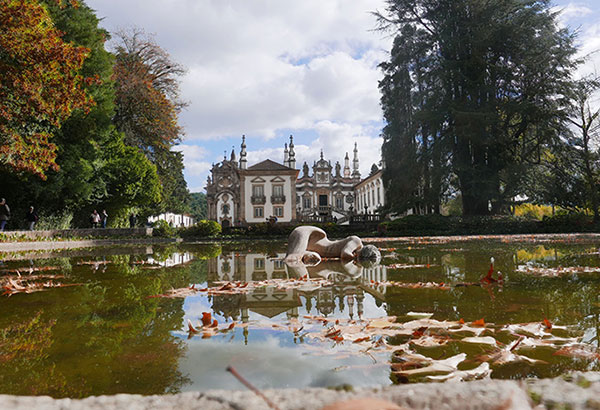Portugal is pulsating in one bend and solemn in the other


Palacio De Mateus is a palace located in the civil parish of Mateus, municipality of Vila Real, Portugal.
Let me begin my travel diary of Portugal with how I enjoyed a fado dinner in the city capital of Lisbon. In a quaint restaurant that serves traditional Lisboa cuisine, a chanteuse began to regale us with her songs. Her voice was soft and serene; a hint of lamentation was heard in her timbre and felt in her facial expression. I was quiet but the performance before me was enchanting. It was the same feeling I got when a few months back I was immersed watching an after-dinner flamenco performance in Seville.
Just when the lady’s voice started to seep through me, the solemnity of her voice was belied by an upbeat and electrifying song and dance number from a group of young and old Portuguese, some with guitars and mandolins. The waiters joined the dancing. And soon, there was a party inside the restaurant with the diners joining in the festivity. Most of the fado performers, I would learn later on, belong to one family. And the restaurant is family-owned, too. The waiters, the cashier, the performers are a family that works together. A fado dinner is the traditional Portuguese way of entertaining their guests. They themselves give their personal service to make sure guests are satisfied. And service to them is delivered with love, warmth and grace.
That fado scene alone is enough for me to decide that Lisbon is mad.
Lisbon has a touch of Madrid in a sense that it is fun. It has the romantic vibe of Paris and the somehow laid-back atmosphere of Rome.
The largest city of Portugal is beautiful, enthralling, encompassing. It is nestled on seven hills in the northern side of Portugal’s most attractive natural harbor, perfectly in the gaping mouth of Rio Tejo (Tagus River). Roam around Lisbon and you will discover that on each hill is a treasure trove that guards a castle, a church, and each one reserves a guest a splendid miradouro (viewpoint).
Our Trafalgar travel director Pedro Pinto, filled with wit and wisdom all throughout our tour, said many of the medieval buildings in Lisbon were destroyed when a massive earthquake hit the city in 1755. The government and the architects of Portugal rebuilt the city in Baroque style.
To visit Lisbon is to get lost in the mazelike Alfama district, which has remained in its original state. Its narrow cobbled streets are an attraction in themselves. Old and new trams ply these streets. Funiculars, too, compete alongside an extensive metro system. It helps that in your sojourn you have a delightful discovery of the famous Portuguese custard tarts.
This trip to Portugal, arranged by Trafalgar Tours (represented in the Philippines by its general sales agent Helen Hao), started when we embarked on a very posh Qatar Airlines flight from Manila. We flew comfortably to Doha then connected to Madrid and then to Lisbon on a local carrier. Qatar Airlines is by far among the most luxurious airlines with its cuisine and wines of impeccable selection.
The more you stay in Lisbon, the more it beguiles you to discover it. Be mesmerized at the ancient Tower of Belem or ogle the gigantic Monument to the Discoveries. The Tower of Belem, also called the Tower of St. Vincent, is a fortification that is listed in the UNESCO World Heritage Site (along with the nearby Jerónimos Monastery) because this iconic Portuguese symbol played an important role in the country’s maritime breakthroughs during the era of the Age of Discoveries.
One thing not to miss when in Lisbon is the opportunity to find one’s way to Fatima, a civil parish in the municipality of Ourem. The serenity of Fatima lends to a very pious visit to this place. At the miraculous Fatima, we witnessed the basilica or the Chapel of Apparitions, enshrined to remind the faithful of the appearance of the Virgin Mary to the three young shepherds in 1917. Next year will be its centennial and even now, the populace is gearing up with so many festivities for this milestone. The Fatima inspires a Virgin Mary devotee to believe more in the power of God. Inside the basilica, you feel your prayers are whispered closely to God.
We proceeded to Oporto where we stayed for the next two nights in Hotel Villa Porto, a very cozy hotel in the heart of the city.
How can we forget the gastronomic savories at Nazare, a fishing port with restaurants by the beachfront? We had the most delicious fish stew simmered in special spices. Nazare is a colorful fishing village in central Portugal. Located almost 80 miles north of Lisbon, the village will not disappoint those looking for a peaceful vacation. With a beautiful sandy beach and rhythm of the pounding waves, Nazare is a perfect place for undisturbed walks along the shore, surfing, tanning and, of course, fishing.
Nazare gets its name from the statue of the Virgin Mary, which was brought to Nazareth by a monk in the 4th century.
In Nazare, ride the funicular located 360 feet above the main town and enjoy the panoramic views. Its sitio has a chapel called Capela de Memoria built in the 12th century to commemorate a miracle.
A local specialist then took us on a sightseeing tour of Oporto where we saw the remarkable bridges across the Douro River and the Baroque church of St Francis. We visited the Stock Exchange Palace with its splendid Arabian Hall and then experienced a cultural insight into the traditions of local wine production at a tasting port cellar. The Porto wine tasting at the Sandemans Port Cellar was most interesting as we learned about the history of port wine and even sampled three of its finest wines.
To give you an idea of the Oporto cuisine that we sampled at Restaurant Marisqueira Proa, we had vegetable soup, croquettes, patties and cod cookies, hake fillets with Russian salad, fish paella, cod in cream sauce and grilled or roast sea bass, roast leg of pork and lime pie with fresh fruit salad.
Our experience of Portugal continued to Guimaraes for views of the impressive castle in Visea, where we also explored the magnificent gardens at Palacio de Mateus. We traveled through the expansive Douro Valley where port wine is produced before arriving at Viseu, a bustling town with historical buildings set high on a plateau near the famous Dao vineyards. We spent the night at Grao Vasco. We had lunch at the Quinta de Marrocos Winery with a tour of the winemaking process.
From Viseu, we continued south to Belmonte where we visited the Roman tower. After crossing the valley of the River Tagus towards the Serra de Estrela Mountains, we then visited the Castillo de Vide and wandered through narrow alleys and the town’s Jewish quarter. Later, we arrived in Evora, one of Portugal’s most beautifully preserved medieval towns. We spent the night at hotel M’AR De Ar Muralhas.
Unforgettable, too, was the Castelo de Vide, a small town seven kilometers from Quinta do Pomahinro and described by the ANWB guide as the best-preserved medieval town of Portugal. The picturesque town of Castelo de Vide is located in the Alto Alentejo region and lies on the slope of one of the northern foothills of the Sierra de Sao Mamede. In the past, it was an important stronghold on the Spanish border, but now it is a sleepy town with a wonderful charm where time seems to stand still.
Castel de Vide has a 14th-century castle in which you can still feel the past. Furthermore, there is a beautiful Jewish neighborhood with the oldest synagogue of Portugal and many special, often gothic door portals. In the Jewish neighborhood, there is also the roofed Fonte de Villa, a marble Renaissance fountain from the 16th century. For lovers of old churches and chapels, you can find no less than 32 of them in Castelo de Vide.
Trafalgar’s Be My Guest feature is another treat for Trafalgar passengers who get to experience how it is to dine with local folk, each sharing their own stories. For this trip, Trafalgar had an exclusive visit to a stud farm, where we were treated to the tragic story of unrequited love over a traditional homecooked meal by Tiago and Vera in the beautiful Alentejo.
The stud farm was founded in 1778 when the King of Portugal, Don Joao VI gave Jacinto Paes de Matos the right to the farm and the right to raise the horses there. When the King visited the stud farm with his wife, Jacinto fell in love with her and vowed never to love anyone else. Jacinto kept this to himself and endured this unexpressed love. The 1,000-hectare estate is home to some 250 cattle, 500 sheep and 32 horses.
Our farewell dinner at Rua da Alfandega included tapas, green salad with olives and goat cheese and smoked ham, codfish fried croquettes and red bell pepper couli, prawns flambé with Madeira wine, grilled asparagus with carrot puree, Alfandega’s roast beef and cubed fried potatoes apple and wild berries crumble for dessert.
There was dancing and singing among new friends. It was like the fado night again. Indeed, Portugal pulsates one moment, only to become solemn the next. It is this combination of energies that make this country a must to visit.
* * *
For more information, Pan Pacific Travel Corporation General Sales Agent call +632 526-8404, 523-1990, 526-6427, 536-1267, 536-1265 or visit their website www.trafalgar.com.



















